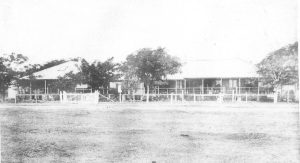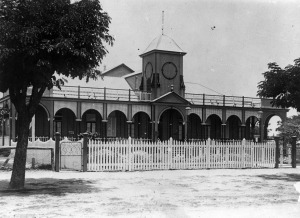Empty wool sacks were stacked high in the huge, corrugated iron wool shed, returned from wool stores in the city and ready to be refilled next shearing season. When their father, Fred, took the kids with him on a visit to the shed they would play on the piled wool sacks, jump on them, hide under them, put them over their heads.
Fred was the manager of Tara sheep station, outside Barcaldine. It was 1929, and his second child, my mother Pat, was nine years old.
 Bottle tree and canvas water bag, Tara homestead, 2000
Bottle tree and canvas water bag, Tara homestead, 2000Wool prices were strong. Later that year, Wall Street would crash and the Great Depression would loom. Life would change suddenly for millions world-wide; but for now, Fred’s four children enjoyed a fine and privileged childhood, with a big homestead and garden, dogs and ponies, peacocks, a billy goat cart, fresh meat, milk, vegetables and fruit produced on the station, and the occasional visit to town, a few kilometres away.
 Pat on her pony, in front of the old Tara homestead c.1929
Pat on her pony, in front of the old Tara homestead c.1929Living on a sheep station in central western Queensland, where the air is dry, populations are small and distances are huge, the children were healthy, rarely suffering so much as a common cold.
Then Pat caught diphtheria.
Before effective and widespread vaccination, this was a dreaded disease, especially among children. According to Queensland Health,
With respiratory diphtheria a person can experience a sore throat, fever, enlarged lymph nodes and swelling of the soft tissues on both sides of the neck sometimes referred to as a ‘bull neck’. Within two or three days a membrane (a white or grey film) forms over the throat and tonsils that can make it difficult for the person to swallow and breathe.[1]
This is a bacterial disease, and that grey film is toxic.
There were vaccines, but they could be problematic. In 1928, there had been a tragic occurrence in Bundaberg when a batch of the diphtheria vaccination had become contaminated, and twelve children died.
Dangerously ill, Pat was admitted to the isolation ward of Barcaldine’s Victoria Hospital, along with three other infected children.
 Barcaldine Hospital, c. 1930
Barcaldine Hospital, c. 1930One evening she or one of the other children reached a crisis, and Dr James Cook, who had been the hospital superintendent since 1898[2], was called urgently to the isolation ward. According to the local newspaper: …in going across to the isolation ward in the dark about 8 p.m. the doctor fell over a form or some other obstacle and sustained a severe wrench or dislocation to his hip. The Doctor is now an inmate of the hospital.[3]
Dr Cook was months in hospital in Brisbane and never returned to work.
As Pat recovered, the family could only wave to her from outside the hospital fence. Her mother sent baskets of fruit and vegetables to the hospital from the Tara gardens. In time she was well enough to go home, but her heart muscle had been strained.
In 1976, and because her heart had weakened by her childhood diphtheria, Pat died of a heart attack, aged just fifty-six.
The isolation wing at Barcaldine’s Victoria Hospital had been built in 1921, after the Spanish Influenza viral epidemic swept the world.
In mid-1919, ten years before Pat had her battle with diphtheria, the ‘flu had come to Barcaldine. Her grandfather Frank, manager of the Queensland National Bank in Barcaldine, caught it, along with his wife and son. Frank died. According to the family story, Frank was already ill with kidney disease – a “pre-existing condition”, in our current language. Pat’s father Fred, Frank’s son-in-law, wrote to his brother about the death.
…he died about 11.15 on Wednesday night, and from what I can understand, just previous to dying he suffered great agony. I believe the cause of death was heart failure as at the latter end only half of his heart was working.
A report in Barcaldine’s newspaper, The Western Champion, seems familiar today, as we again face a world-wide epidemic.[4]
A proclamation was issued by the Government on Friday, ordering that, from the 30th of May and until the 31st of July next or such later date as may be prescribed every Church, Sunday school, school, or college, place of public amusement or resort, theatre, hall, dancing room, gymnasium, or other place or premises where people regularly or occasionally congregate for worship, education, meeting, amusement, entertainment, dancing, physical culture, or athletics shall be closed to the public.
 Women wearing surgical masks during influenza epidemic, Brisbane 1919 “Influenza pandemic”, nma.gov.au
Women wearing surgical masks during influenza epidemic, Brisbane 1919 “Influenza pandemic”, nma.gov.auIn Barcaldine alone there were over one hundred sufferers. Anyone with symptoms was told to report to Dr Cook, and if deemed to have the ‘flu they were put into isolation in their own homes or in the isolation hospital established in the Shire Hall. Patients were urged to strictly obey the doctor’s orders.
 Barcaldine Shire Hall State Library of Queensland
Barcaldine Shire Hall State Library of QueenslandThe Queensland public were reassured that the epidemic would run its course and if they followed instructions the effects would be minimised.
All so familiar to us now, a century later. The media of communication have changed, though, and this week on the Barcaldine Regional Council’s Facebook page, C.E.O. Steven Boxall has been speaking via YouTube about washing hands and safe distances, local closures, and new procedures at the airport.
Typhoid fever, scarlet fever, measles, diphtheria, the plague, polio, tuberculosis, influenza: Australia has had to cope with many epidemics, and quarantine stations were set up in every state to prevent both the arrival of diseases in the country and their spread.
This year’s COVID-19 epidemic is another in a long line. Who knows what it will bring in its wake?
They never found out how Pat caught diphtheria, out on that isolated property. Perhaps it was a visiting carrier. Throat swabs of suspected carriers were carried out frequently.
However, according to the Queensland Health website, while the disease is known to be spread in “respiratory droplets or direct contact with respiratory secretions or infected exudate of infected person or carrier”, it can also be spread through “contact with articles soiled with discharges from lesions of infected people.”[5]
According to the family, it was in the wool sacks.
 Shearing stations, Tara station woolshed, 2000
Shearing stations, Tara station woolshed, 2000[1] http://conditions.health.qld.gov.au/HealthCondition/condition/14/33/40/diphtheria
[2] https://barcaldine-peopleplacesthings.org/government-services/victoria-hospital/
[3] The Western Champion, 18 May 1929.
[4] The Western Champion, 7 June 1919
